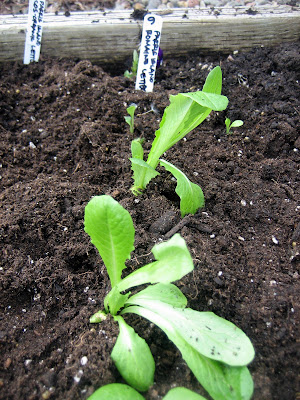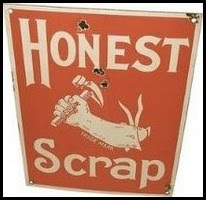This year we started getting our 2010 garden ready back in mid-February. We decided to start some of the plants from the seed stage and grow them large enough to be planted in our garden a couple of months later. By following a chart that lists the planting dates for our area, we were able to plant several types of vegetables as early as February. There are several types of plants that we can still start from the seed stage now and have them ready to plant when we get our garden planted by the end of May.
Although there are several ways you could organize your planting process, I will share what has worked well for us. We call it our Planting Map.
For each box we planted, we labeled the box with a letter [Box A] and then used small tags with numbers on them. Then we listed the name of each plant by the corresponding number on the chart and also showed where the row started and ended for that particular plant. If you look at the picture below, you can see where I used dots to show the seeds and arrows to show where they started and what direction they are planted. Also, we put the corresponding number on the packet of seeds. This turned out to be very helpful, because we had one tray that we had moved to the greenhouse and during a couple of days that we were gone, we had very warm weather and the plants died. We re-planted them in the same numbered area according to the planting map and since the packets were also numbered, the process went quickly.
When we got all of the seeds started that could be planted at that time, we then set up an area in our garage on a workbench fitted with a Jump Start Grow Light System, which has a fluorescent light that hangs above the plants. We also had a Seedling Heat Mat under the plant boxes to help with the growing process. We then watered it with a spray bottle a few times a day and had the lights on about 12 hours a day and turned them off at night. After a few weeks, we began to see some growth!
Once the plants are grown big enough, we transplanted them into another container with separate areas, where they continued to grow until they were large enough to transplant outdoors [see picture below]. Also, in this picture, you can see the fluorescent light fixture at the very top.
Some close-ups of the lettuce and some onions.
When we transplanted them to the second containers, we also moved the numbered tags with them. This is important, so when you plant them outdoors, you will know exactly what each plant is and you can plant them where they grow best.
As you can see from the above pictures, it was time to transplant these again and move them outdoors. We moved all the tomato varieties into our cold frame. A cold frame is basically a wood frame/box that is filled with a dirt, manure, and potting soil mixture that is ready for planting. We had an old sliding glass door that we had kept from our remodel years ago and we lay it over the frame at night, to help keep the plants insulated and warm--which protects them from the cold and helps keep them growing. In the morning, we remove the glass, water the plants (or if it's raining, then mother nature takes care of that) and let them grow by the natural sunlight.
We transplanted 65 tomatoes and 27 hot pepper plants into this cold frame, to give you a perspective of how many plants this frame holds. *I've listed the varieties at the end of this post.
We then moved 38 broccoli spring raab plants to one of the raised beds. We didn't realize how many we had planted or how well they would grow...now we do!
In another raised bed, we planted 33 lettuce plants. This may seem like a lot, but we love those summer salads fresh from the garden.
And a close-up of the Lettuce [Parris Island Romaine] plants.
We also had good luck with these Melons [French Orange Hybrid] and transplanted 14 of these to larger containers, where they will continue to grow in the greenhouse for the next few weeks.
With a little planning and work, you can save money by starting part of your garden from the seed stage, rather than buying everything in the plant stage. The important thing to remember is to watch them carefully, water them regularly and keep them in warm conditions.
Here are the boxes of vegetables and flowers that we've started from seeds (so far):
BOX A
1) Tomatoes [Currant]
2) Tomatoes [Fresh Salsa Hybrid]
3) Tomatoes [Oregon Spring]
4) Tomatoes [San Marzano]
5) Tomatoes [Roma VF Heirloom]
6) Tomatoes [Pruden's Purple Organic]
7) Tomatoes [Red Brandywine]
8) Lettuce [Parris Island Cos-Organic]
9) Lettuce [Parris Island Romaine]
10) Lettuce [Spinach Tyee Hybrid]
11) Pepper [California Wonder]
*This next section contains seeds from several varieties of peppers that we grew in 2009. I don't have the exact name for some of them; instead I described them.
BOX B
12) Peppers [2009 Jalapeno]
13) Peppers [2009 Long, green, HOT]
14) Peppers [2009 Small, red, HOT]
15) Peppers [2009 Little, HOT]
16) Peppers [2009 Medium size, HOT]
17) Broccoli Spring Raab
18) Melons [French Orange Hybrid]
BOX C
19) Lettuce [Butter Crunch]
20) Lettuce [Green Salad Bowl]
21) Lettuce [Carmona Organic]
22) Summer Squash [Aristocrat Zucchini Hybrid]
23) Oregano [True Greek Organic]
24) Money Plant
25) Red Poppy
BOX D
26) Asters
27) Marigolds [Lemon Drop]
28) Marigolds [Cracker Jack]
BOX E
29) Marigolds [Star Fire]
30) Marigolds [Frances Hoffman]
31) Marigolds [Dwarf]
32) Snapdragons
33) Hollyhocks
34) Parsley [Curly]




















I am really impressed! I started seeds inside, but didn't have much space so I ended up moving them outdoors so they didn't grow much, it got cold again! The tomatoes are finally growing but it took forever.
ReplyDeleteDid you ever plant cherokee purple or black krim tomatoes? They are my favorites together with sungold a very cold resistant variety.
I have lots of beets this year, it seems that every year I learn new things and my veggie growing improves.
Happy planting!
How exciting. We only have a small veggie patch, so I'm a bit jealous of how many things you've planted :) Looking forward to seeing all your produce!
ReplyDeleteWow! I never knew planting needs so much work and planning! Thanks for sharing!..it's like a whole subject that you need to study on!
ReplyDeleteWow! Your garden looks amazing already, and it's only May!! I'm so jealous. I need to start planting soon.
ReplyDeleteBeautiful job, Jill--and I'm assuming, Luana! I hope the weather cooperates and you earn the reward of your labors!
ReplyDelete